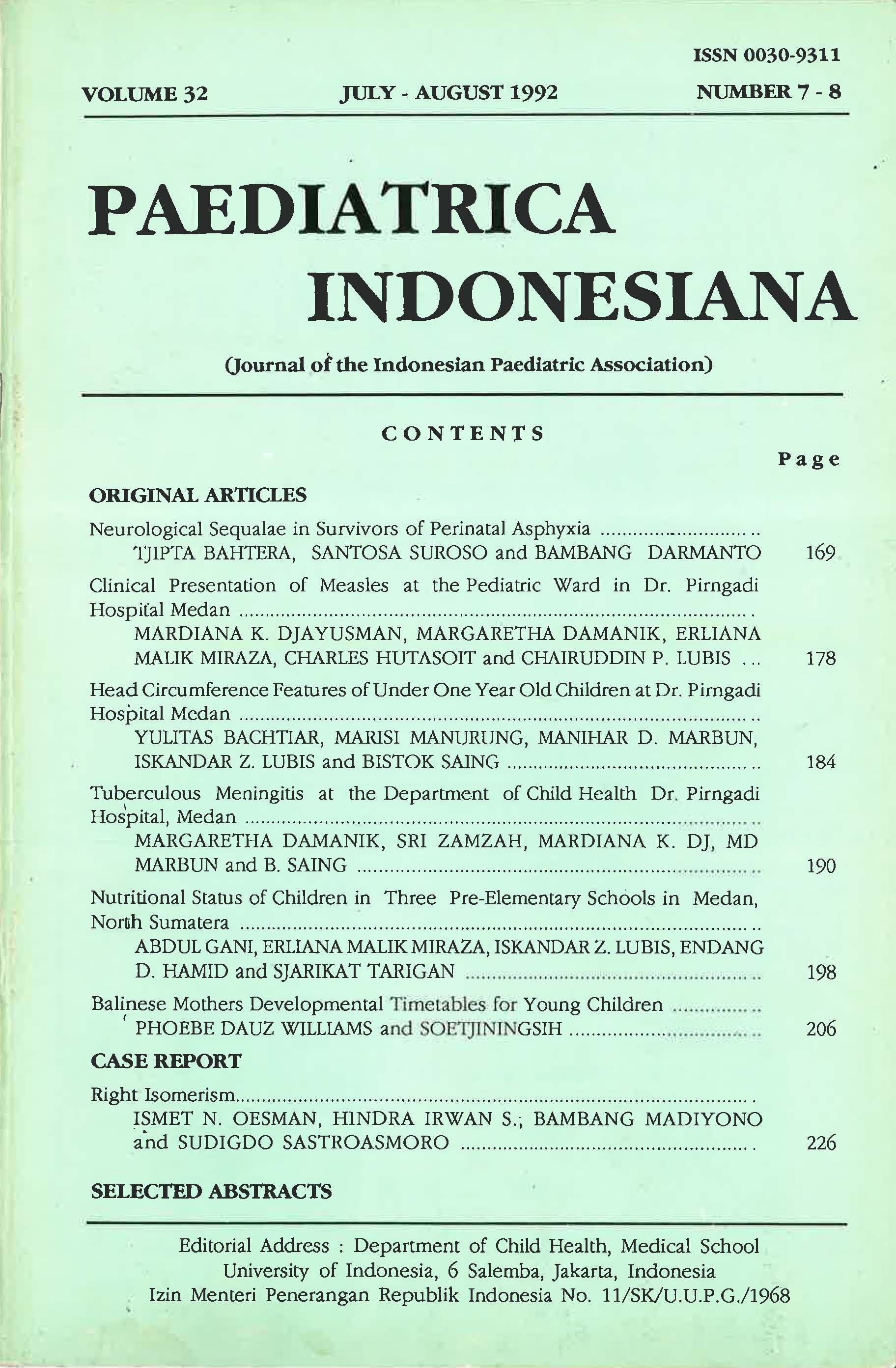Neurological Sequalae in Survivors of Perinatal Asphyxia
Abstract
Perinatal asphyxia is the most common cause of either death or severely handicapped survivors. Perinatal asphyxia can be identified by one, five, ten minutes APGAR scores less than 7. Prolonged asphyxia produce hypoxemia, acidosis, hypercapnia, thus diminishing cerebral blood flow, which in turn results in clinical patterns of Hypoxic - Ischemic Encephalopathy (HIE). The atm of this study was to evaluate the accuracy of clinical observation on newborn asphyxia to predict the presence of neurological deficits connected with blood gas analysts investigation. Thirty eight newborn babies who bad APGAR scores of less than 7 as an asphyctic newborn baby group compared with an equal number of normal babies as control group. Physical and neurological examinations were performed immediately after birth and at six months of age. Two of the 38 infants who bad perinatal asphyxia died several hours after birth. Two of the 31 of the surviving infants with a historical of perinatal asphyxia bad cerebral palsy. One of the two babies with cerebral palsy bad epilepsy. Twenty nine of the 31 of the surviving infants with a history of perinatal asphyxia with or without mild HIE showed normal neurological outcomes. All of the normal newborn babies as control showed normal neurological outcome. One infant with cerebral palsy and one infant who bad cerebral palsy with epilepsy bad a history of a severe degree of HIE and moderate degree of Hm with neonatal convulsion respectively. One of the 2 infants with cerebral palsy bad severe hypoxia and none on the infants with normal neurological outcome exhibited Pa02 less than 50 mmHg. There were no significant differences ( p > 0.05) of the Pa02 PH and base deficit between the infants with a history of asphyxia and with a history of a vigorous baby, who bad a normal outcome.
We concluded that postasphyxia encephalopathy was more accurate than a low APGAR score in predicting an adverse outcome, and the value of the Pa02 very important in predicting an encephalopathy.
References
2. Levene Ml, Fenton AC. Severe birth asphyxia and abnormal cerebral blood - flow velocety. Develop Med Child Neurol 1989 ; 31 : 427-34.
3. VolveJJ. Hypoxic Ischemic Encephalopathy. Neurology of the Newborn. 2nd ed. Philadelphia: WB Saunders 1987 : 16o - 272.
4. Robertson C, Finer N. Term infants with hypoxic - aschemic encephalopathy : outcome at 3 - 5 years. Develop Med Child Neurology. 1985 ; 27 : 473 - 84.
5. Fenichel GM, Hypoxia Ischemic Encephalopathy in the New Born. Arch Neurol 1983 ; 40: 261-6.
6. Levane MI, Grindulis H, et a!. Comparison of two methods of predicting outcome in perinatal asphyxia. Lancet 1986 ; ii : 67- 8.
7. Roberton GMT, Finer NN, Grace MGA. School performance of survivors encephalopathy associated with asphyxia at term. J Pediat 1989 ; 114:753-60.
8. Menkes JH. Perinatal Asphyixia and trauma. Texboox of child Neurology 4 ed. Philadelphia; Lea & Febiger, 1990: 286-316.
9. Synkes GS, Yohnson P, et al. Do APGAR scores indicate asphyxia ?. Lancet 1982 ; 27 : 474-96.
10. Nelson KB, Ellenberg JH. Neonatal Signs as Predictors of Cerebral Palsy. Pediatrics. 1979; 64 : 225- 31.
11. Nelson KB, EllenbergJH. APGAR Scores as Predictors of Chronic Neurologic Disability. Pediatrics 1981 ; 68 : 36-43.
12. Adsett DB, Fitz CR. Hypoxic ischaemic cerebral injury in the term New Born Correlation of CT findings with neurological autcome. Develop Med Child Neurol 1985 : 155- 60.
13. Low YA, GalbraitH RS. Intrapartum fetal hypoxia : A study of long term morbidity. Am. J Obstetric Gynecology 1983 ; 15 : 129-34.
14. De Souza SW, Richards. Neurological sequelae in new born babies after perinatal asphyxia. Arch dis in child 1978; 53 : 564-9.
15. Nelson. The onset of Respiration. in Avery GB. ed. Neonatology. P.athophysiology and Management of the Newborn. 2nd ed. Philadelphia: JB Lippincott 1987 : 176- 97.
16. D Sauza $W, Me Cartney E., et al. Hearing, speech and language in survivors of survivors of severe perinatal asphyxia. Arch of Dis in Child 1981 ; 56 : 67 - 8.
17. Nelson KB, Ellenberg JH. Children who outgrew Cerebral palsy. Pediatrics 1982 ; 69 : 529-35.
18. Torfs CP, Van Den Berg BJ. Prenatal and perinatal factors in the etiology of cerebral palsy. J Pediat 1990 ; 116 : 615-9 .
Copyright (c) 2019 Tjipta Bahtera, Santoso Suroso, Bambang Darmanto

This work is licensed under a Creative Commons Attribution-NonCommercial-ShareAlike 4.0 International License.
Authors who publish with this journal agree to the following terms:
Authors retain copyright and grant the journal right of first publication with the work simultaneously licensed under a Creative Commons Attribution License that allows others to share the work with an acknowledgement of the work's authorship and initial publication in this journal.
Authors are able to enter into separate, additional contractual arrangements for the non-exclusive distribution of the journal's published version of the work (e.g., post it to an institutional repository or publish it in a book), with an acknowledgement of its initial publication in this journal.
Published 2019-01-30













